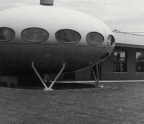
When State Senator Frank Panzer, a Republican so old-school that he was born during the presidency of Civil War general Benjamin Harrison, died shortly after Richard Nixon became president in 1969, he left behind a legacy as a former La Follette Progressive who had settled comfortably into the mainstream of the Republican Party and diligently represented the GOP heartlands east of Madison for the better part of four decades. Republican governor Warren Knowles, just reelected as a moderate with a concern for the environment and a willingness to fund social welfare programs, called a special election with every expectation that, before the end of the turbulent year, another orthodox Republican would be elected to occupy the seat for another few decades. Instead, GOP primary voters upended the expectations of party leaders by nominating a twenty-four-year-old right-wing firebrand who declared that “the Republicans spend too much” and was described in media reports as the candidate who “makes conservatives look liberal.”1
Thus began the most raucous special election in Wisconsin history, a contest that would immediately alter the politics of the state and, over time, the nation. Before the voting in the fall of 1969 was done, national conservatives such as then California governor Ronald Reagan and National Review editor William F. Buckley Jr. had turned their attention to the competition in east-central Wisconsin’s Jefferson, Dodge, and Washington Counties. Democrats were taking swipes at the Republican nominee as a “student radical,” Republican stalwarts wrestled briefly with the prospect of having their party’s nominee stand down, charges of dirty tricks and spying and vandalism abounded, and Richard Nixon’s office had to clarify that the Republican president was not supporting the Democratic nominee against his own party’s candidate. When all was said and done, a Democrat won the seat for the first time in half a century, which transformed the dynamics of the legislature’s upper chamber and put the party in position for the sweeping victories that, a year later, would confirm once and for all that Wisconsin was a two-party state.2


But that was only the beginning of the story. Instead of sticking around for another run at what had been a reliably Republican seat, the defeated conservative headed off to Washington to join the staff of Vice President Spiro Agnew, beginning a career in which he would define the New Right in American politics as an aide to Ronald Reagan, a counselor to Republican presidents and presidential candidates from the 1970s to the 2010s, the longtime chairman of the American Conservative Union, and the president of the National Rifle Association.3
So it was that David Keene, the loser of a state senate contest in Wisconsin, became what conservative columnist George Will would by the late 1970s be calling “a Maker of History and Shaper of Destiny.” What if Keene had won that special election back in 1969? Would the charismatic young conservative have become a transformative figure in the state’s Republican Party, as did his University of Wisconsin Law School classmate and frequent collaborator on conservative projects, Tommy Thompson? Thompson thinks so. “If he had won, I think he would have had a significant political career in Wisconsin,” says the former governor. “I think he would have served a few terms in the state senate and then run for governor or for senator.” Instead, Keene became, in the words of Americans for Tax Reform founder Grover Norquist, “a conservative Forrest Gump,” a strategist who would stand at the side of every major figure on the Right and at or near the heart of every major political battle within the Republican Party over the ensuing five decades.4
Keene remembers his bid for the 13th state senate seat not with bitterness but rather with a sense of historical irony. He says he took what he learned in




